Friction Torque Analysis and Verification of Planetary Thread Roller Bearing
Abstract
:1. Introduction
2. Prerequisite
2.1. Structure Description
2.2. Contact Property
3. Friction Torque Model
3.1. Friction Torque Caused by Material Elastic Hysteresis
3.2. Friction Torque Caused by Roller Spin-Sliding
3.3. Friction Torque Caused by Differential Sliding
3.4. Friction Torque Caused by Planetary-Roller Sliding
3.5. Friction Torque Caused by Viscous Resistance
4. Analysis of Factors Affecting Friction Torque
4.1. Effect of Roller Number on Friction Torque
4.2. Effect of Load on Friction Torque
4.3. Effect of Rotating Speed on Friction Torque
5. Experiments
5.1. Experimental Setup
5.2. Main Results
6. Conclusions
Author Contributions
Funding
Institutional Review Board Statement
Informed Consent Statement
Data Availability Statement
Conflicts of Interest
References
- Qiao, G.; Liu, G.; Shi, Z.; Wang, Y.; Ma, S.; Lim, T.C. A review of electromechanical actuators for More/All Electric aircraft systems. Proc. Inst. Mech. Eng. Part C J. Mech. Eng. Sci. 2018, 232, 4128–4151. [Google Scholar] [CrossRef] [Green Version]
- Quattrocchi, G.; Iacono, A.; Berri, P.C.; Vedova, M.D.L.D.; Maggiore, P. A New Method for Friction Estimation in EMA Transmissions. Actuators 2021, 10, 194. [Google Scholar] [CrossRef]
- Fu, X.; Liu, G.; Ma, S.; Tong, R.; Lim, T.C. A Comprehensive Contact Analysis of Planetary Roller Screw Mechanism. J. Mech. Des. 2016, 139, 012302. [Google Scholar] [CrossRef]
- Fu, X.; Liu, G.; Ma, S.; Tong, R.; Lim, T.C. Kinematic Model of Planetary Roller Screw Mechanism with Run-Out and Position Errors. J. Mech. Des. 2018, 140, 032301. [Google Scholar] [CrossRef]
- Ma, S.; Liu, G.; Tong, R.; Zhang, X. A New Study on the Parameter Relationships of Planetary Roller Screws. Math. Probl. Eng. 2012, 2012, 340437. [Google Scholar] [CrossRef]
- Ma, S.; Liu, G.; Tong, R.; Fu, X. A Frictional Heat Model of Planetary Roller Screw Mechanism Considering Load Distribution. Mech. Based Des. Struct. Mach. 2015, 43, 164–182. [Google Scholar] [CrossRef]
- Jiang, X.; Wang, B. Analysis on the development of future aero engine technology. Aeronaut. Sci. Technol. 2010, 2, 10–12. [Google Scholar]
- Nguyen, N.; Ong, V.; Villanueva, A.; Hsu, D.; Nguyen, N.; Dhillon, N.; Shankar, P. Design and testing of solid propellant rockets towards NASA Student Launch and Intercollegiate Rocket Engineering Competitions. In Proceedings of the 2018 Joint Propulsion Conference, Cincinnati, OH, USA, 9–11 July 2018. [Google Scholar] [CrossRef]
- Zheng, S.; Fu, Y.; Pan, J.; Li, L.; Wang, D. An In-Depth Study on Load Distribution Characteristics of the Planetary Threaded Roller Bearing. Math. Probl. Eng. 2020, 2020, 9593051. [Google Scholar] [CrossRef]
- Zheng, S.; Fu, Y.; Wang, D.; Pan, J.; Li, L.; Wang, J. A Novel Planetary Thread Roller Bearing: Design and Analysis of Load Characteristic. J. Mech. Des. 2021, 143, 064501. [Google Scholar] [CrossRef]
- Zhou, X.; Zhou, F.; Huang, J.; Ji, J.; Zhong, M.; Yan, Z.; Zheng, B. Friction and wear properties of a new plastic rubber water-lubricated bearing material. In Proceedings of the 2017 4th International Conference on Transportation Information and Safety (ICTIS), Banff, AB, Canada, 8–10 August 2017; pp. 1022–1027. [Google Scholar]
- Wang, F.; Zhou, C.; Zheng, L.; Zhang, H. Improvement of the corrosion and tribological properties of CSS-42L aerospace bearing steel using carbon ion implantation. Appl. Surf. Sci. 2017, 392, 305–311. [Google Scholar] [CrossRef]
- Qin, D.; Xie, L. Modern Handbook of Mechanical Design, 2nd ed.; Chemical Industry Press: Beijing, China, 2019. [Google Scholar]
- Giangrande, P.; Galassini, A.; Papadopoulos, S.; Al-Timimy, A.; Calzo, G.L.; Degano, M.; Galea, M.; Gerada, C. Considerations on the Development of an Electric Drive for a Secondary Flight Control Electromechanical Actuator. IEEE Trans. Ind. Appl. 2019, 55, 3544–3554. [Google Scholar] [CrossRef]
- Li, C.; Xia, X. Uncertainty Evaluation of Bearing Performance Based on Gray Bootstrap Method. In Proceedings of the 2018 3rd International Conference on Computer Science and Information Engineering, Sanya, China, 22–24 October 2018; pp. 403–408. [Google Scholar]
- Battez, A.H.; Fernandes, C.M.; Martins, R.C.; Graça, B.M.; Anand, M.; Blanco, D.; Seabra, J.H. Two phosphonium cation-based ionic liquids used as lubricant additive. Part II: Tribofilm analysis and friction torque loss in cylindrical roller thrust bearings at constant temperature. Tribol. Int. 2017, 109, 496–504. [Google Scholar] [CrossRef]
- Wang, J.; Wang, J.; Wang, X.; Huang, Y. A Threaded Roller Planetary Bearing. CN208057692U, 6 November 2018. [Google Scholar]
- Ravelo, B.; Peyret, N.; Penas, O.; Davin, T. Multiphysics Analysis of Hemispherical Bulk Conductor Hertzian Contact Under Uniaxial Mechanical Load. IEEE J. Multiscale Multiphysics Comput. Tech. 2019, 4, 171–179. [Google Scholar] [CrossRef]
- Armendariz, J.; Treesatayapun, C.; Baltazar, A. Development of an estimated force feedback controller based on hertzian contact and ultrasound. In Proceedings of the 2010 IEEE International Workshop on Robotic and Sensors Environments, Phoenix, AZ, USA, 15–16 October 2010; pp. 1–6. [Google Scholar]
- Lisowski, F. Numnerical Computation of Stresses and Deformations in the Planetary Roller Screw Components. Tech. Trans. 2015, 7, 141–148. [Google Scholar]
- Qiao, G.; Liu, G.; Ma, S.; Shi, Z.; Lim, T.C. Friction Torque Modelling and Efficiency Analysis of the Preloaded Inverted Planetary Roller Screw Mechanism. In Proceedings of the ASME 2017 International Design Engineering Technical Conferences and Computers and Information in Engineering Conference, Cleveland, OH, USA, 6–9 August 2017; pp. 1–9. [Google Scholar] [CrossRef]
- Du, C.; Liu, G.; Qiao, G.; Ma, S.; Cai, W. Transient thermal analysis of standard planetary roller screw mechanism based on finite element method. Adv. Mech. Eng. 2018, 10, 1–10. [Google Scholar] [CrossRef]
- Zhang, W. Model and Method for Calculating the Load Distribution of the Thread Teeth of Planetary Roller Screw Pairs; Northwestern Polytechnical University: Xi’an, China, 2017. [Google Scholar]
- Qiu, M.; Chen, L.; Li, Y. Principle and Application of Bearing Tribology; Defense Industry Press: Beijing, China, 2012. [Google Scholar]
- Jones, A.B. Ball Motion and Sliding Friction in Ball Bearings. J. Basic Eng. 1959, 81, 1–12. [Google Scholar] [CrossRef]
- Houpert, L. Rolling Bearing Torque. In Encyclopedia of Tribology; Springer: Boston, MA, USA, 2013; pp. 2891–2899. [Google Scholar]
- Houpert, L. Numerical and analytical calculations in ball bearings. In Proceedings of the 8th European Symposium, Toulouse, France, 29 September–1 October1999; pp. 1–9. [Google Scholar]
- Olaru, D.; Puiu, G.C.; Balan, L.C.; Puiu, V. A New Model to Estimate Friction Torque in a Ball Screw System. In Product Engineering; Springer: Dordrecht, The Netherlands, 2005; pp. 333–346. [Google Scholar]
- Zaretsky, E.V. A. Palmgren Revisited, A Basis for Bearing Life Prediction. Lubr. Eng. 1998, 54, 18–23. [Google Scholar]

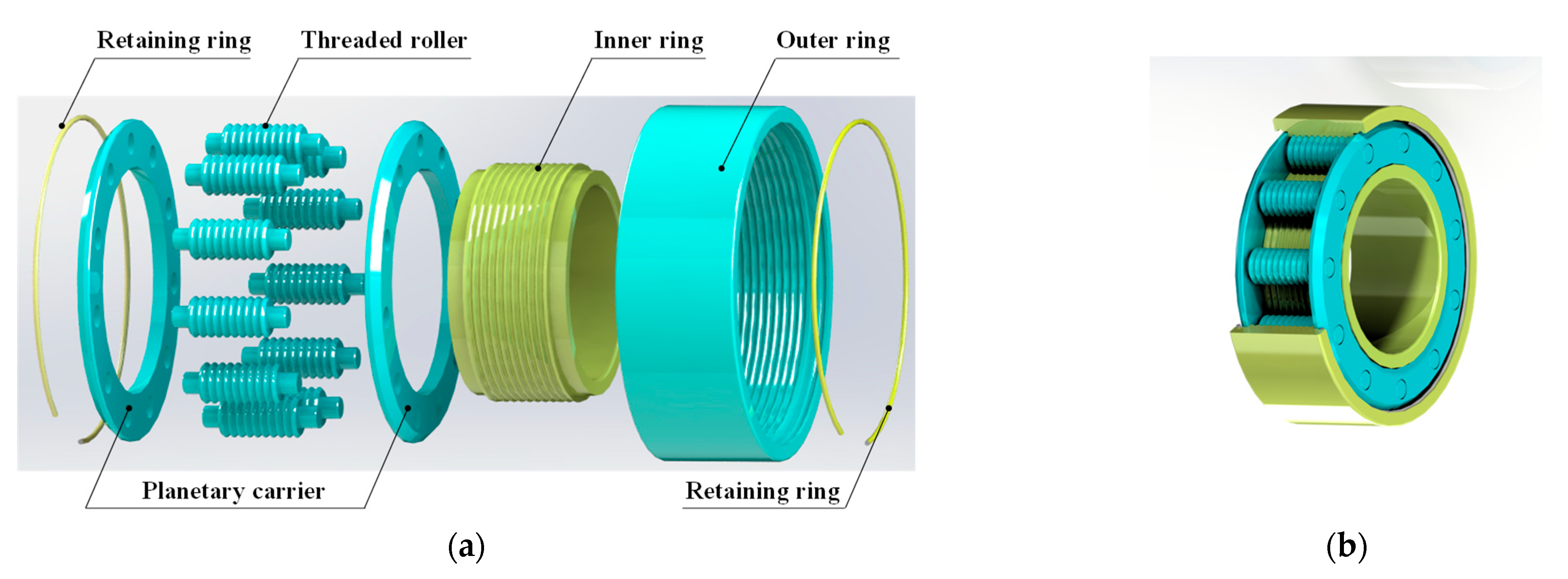
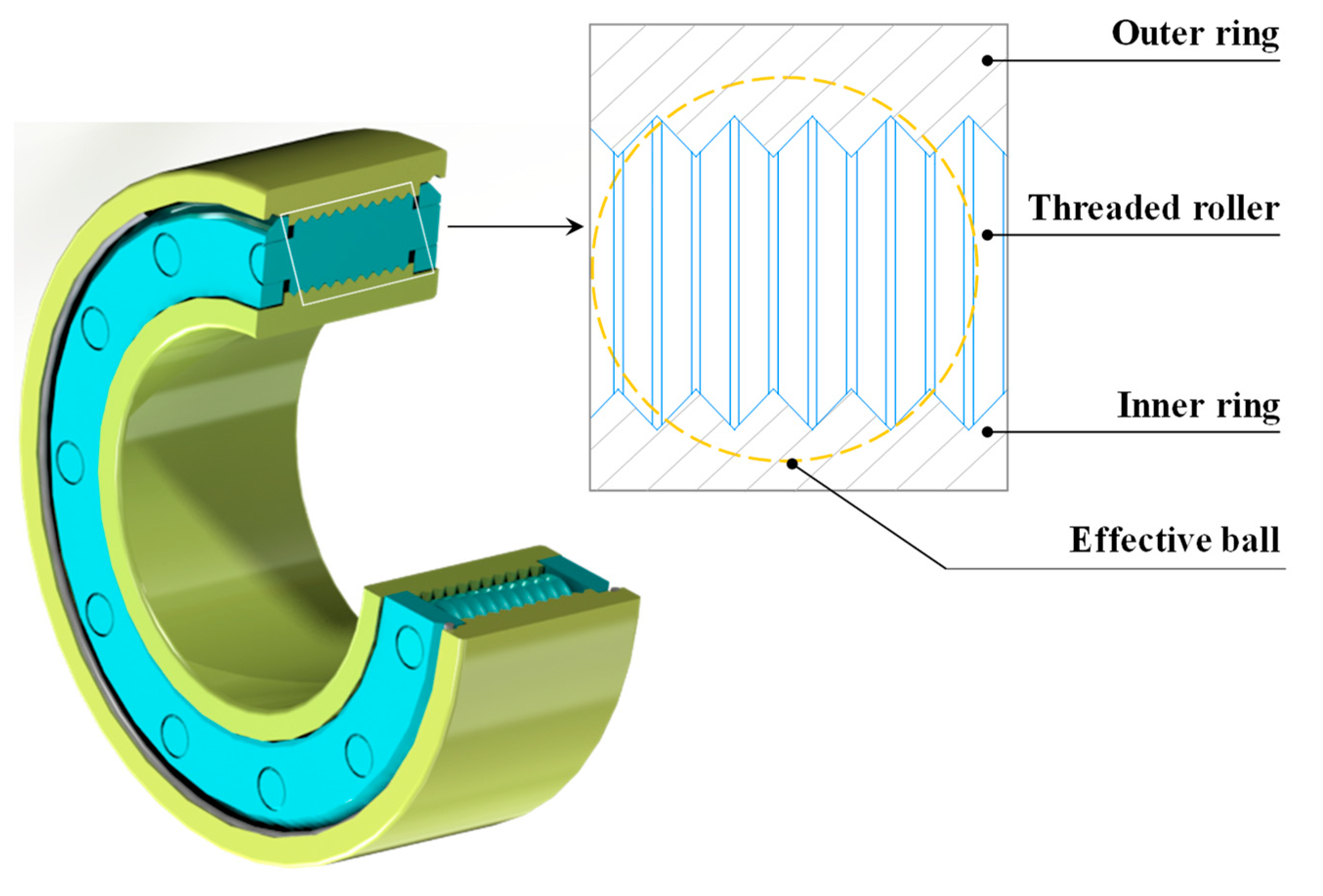
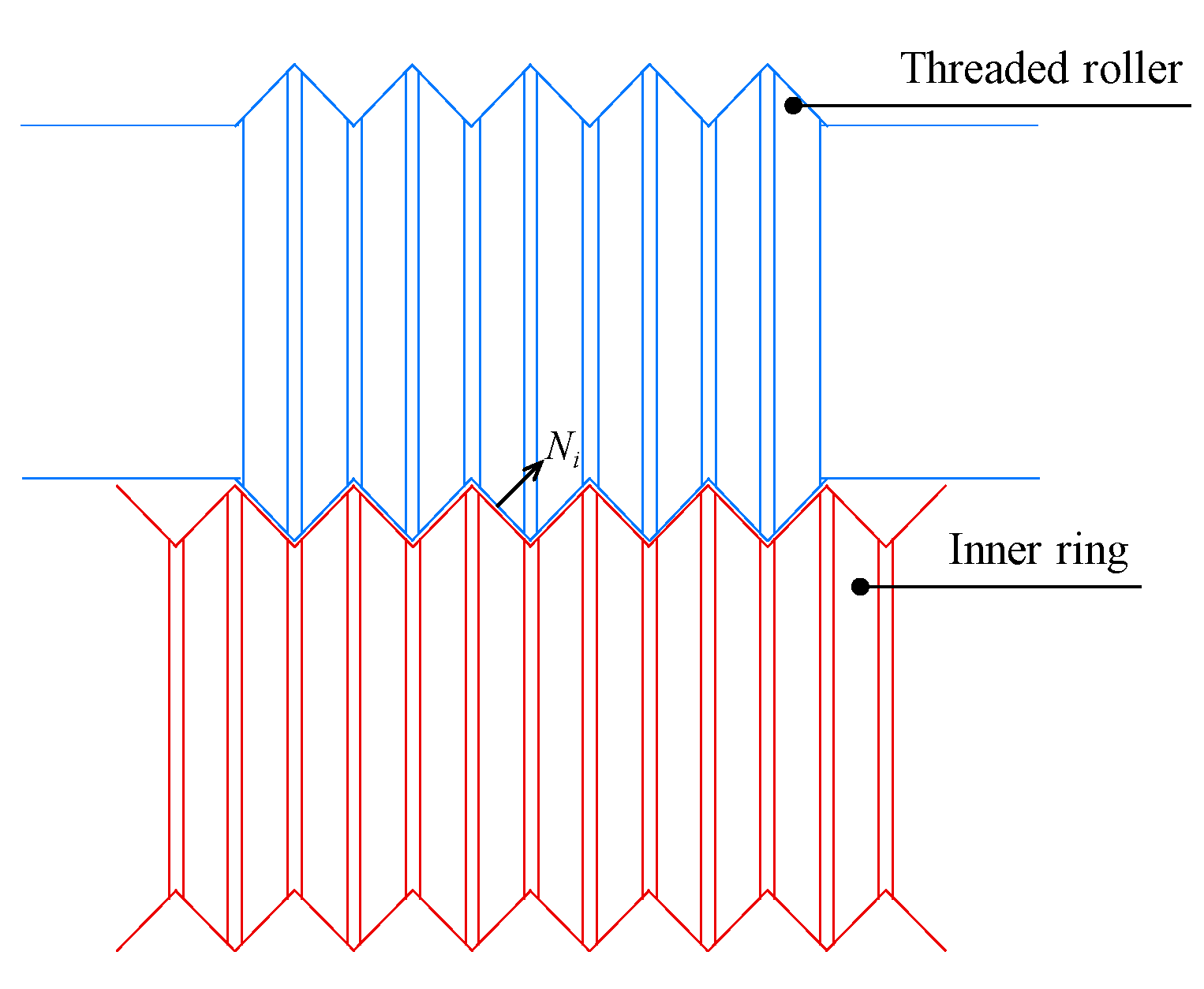
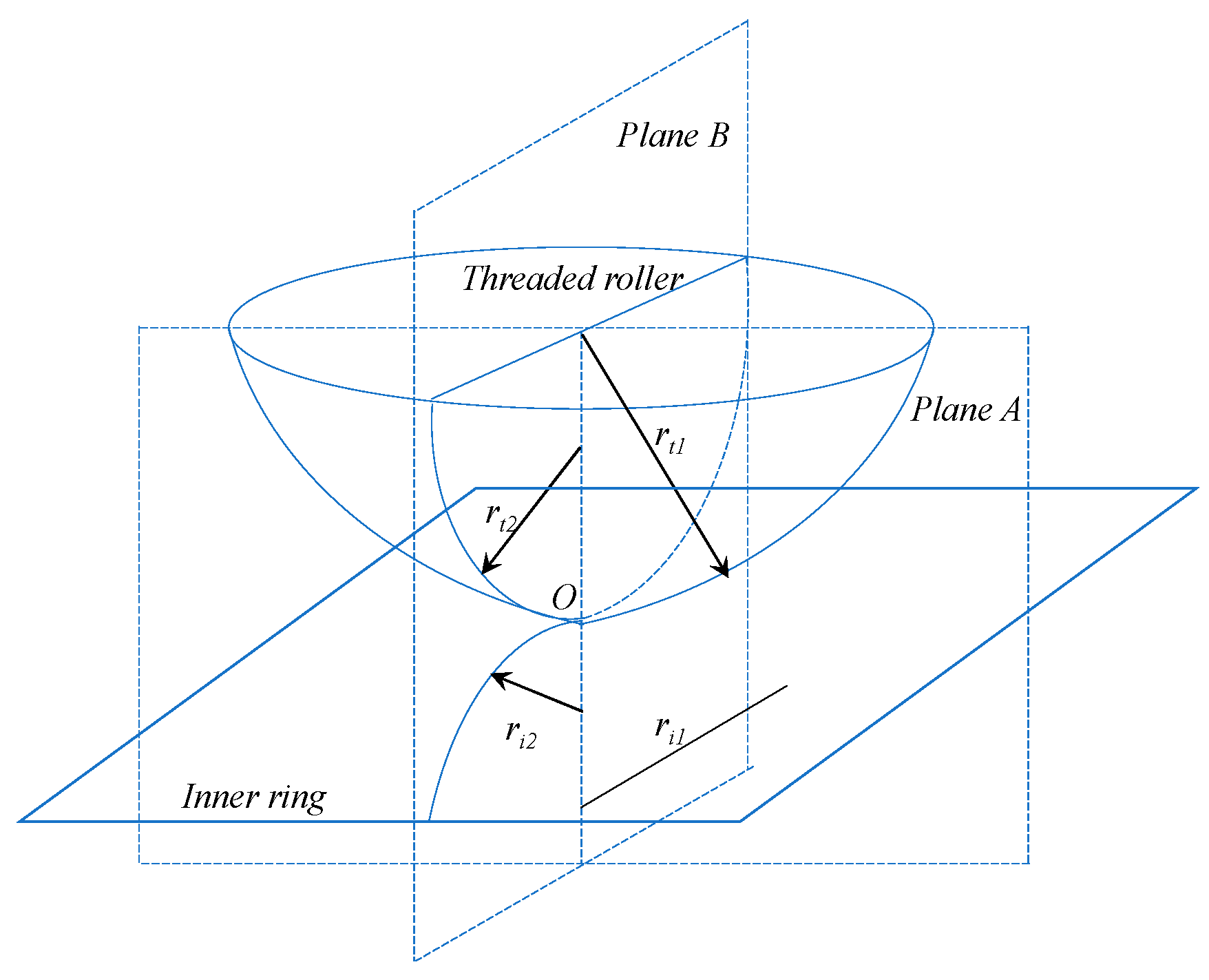

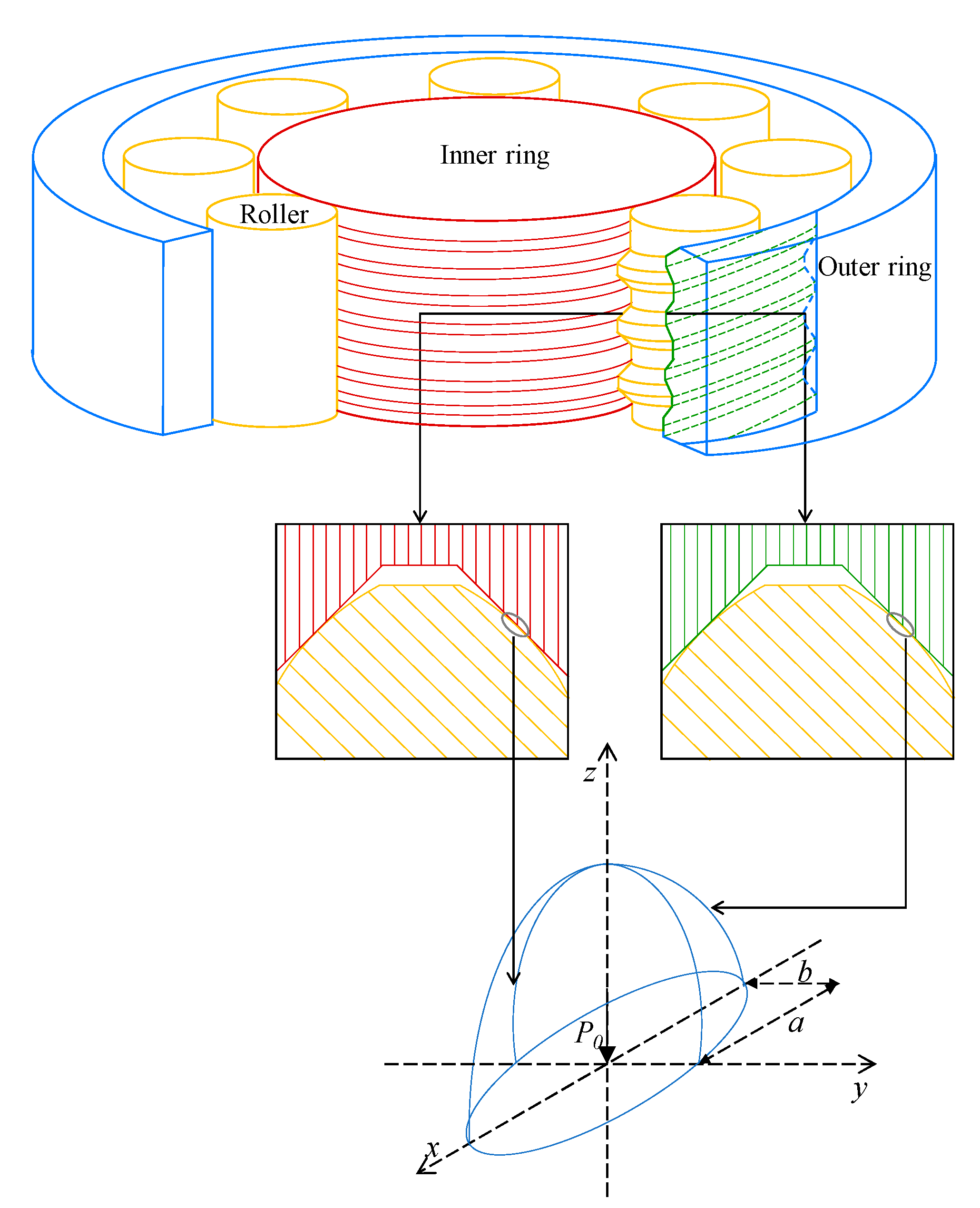
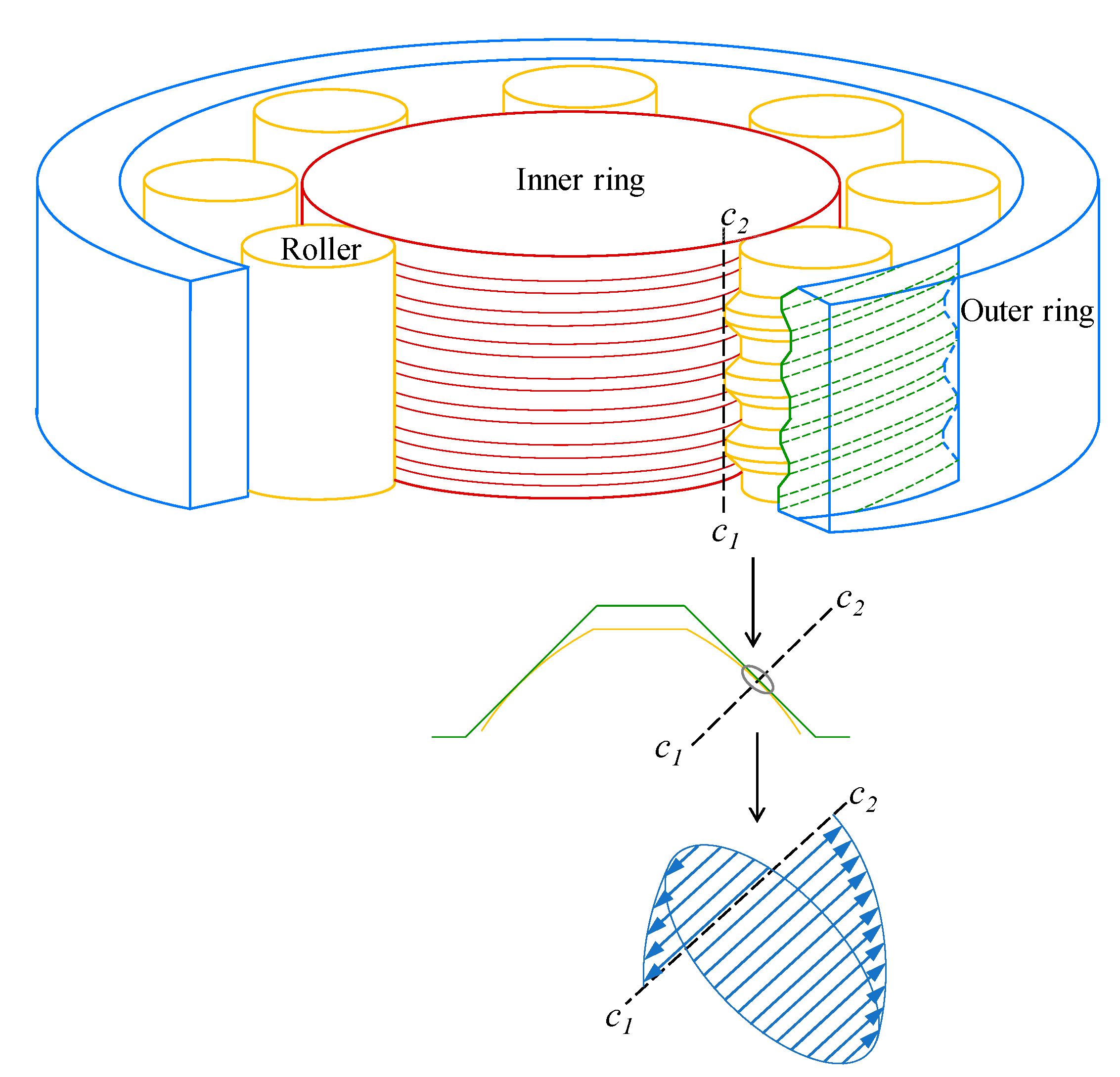
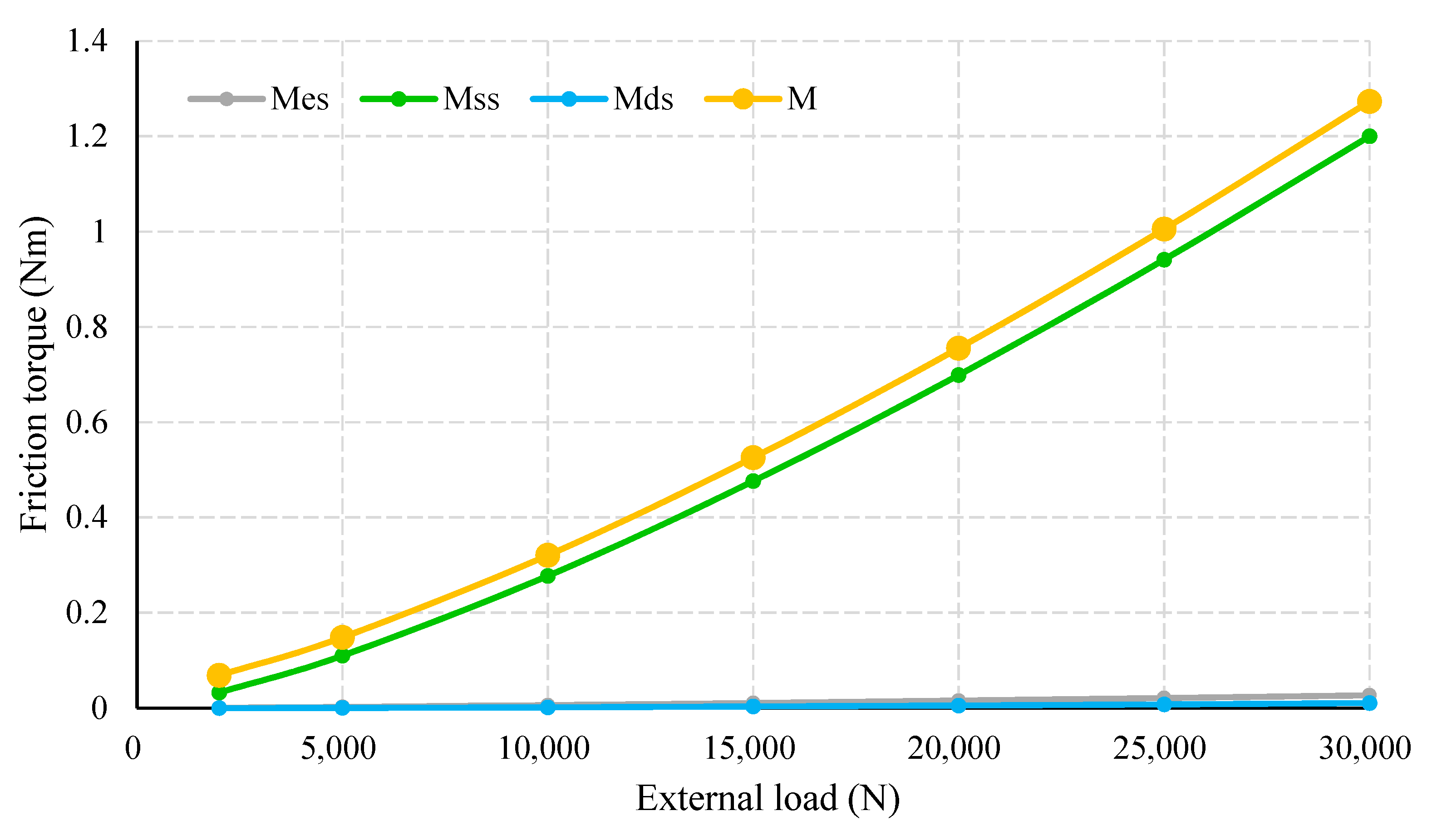
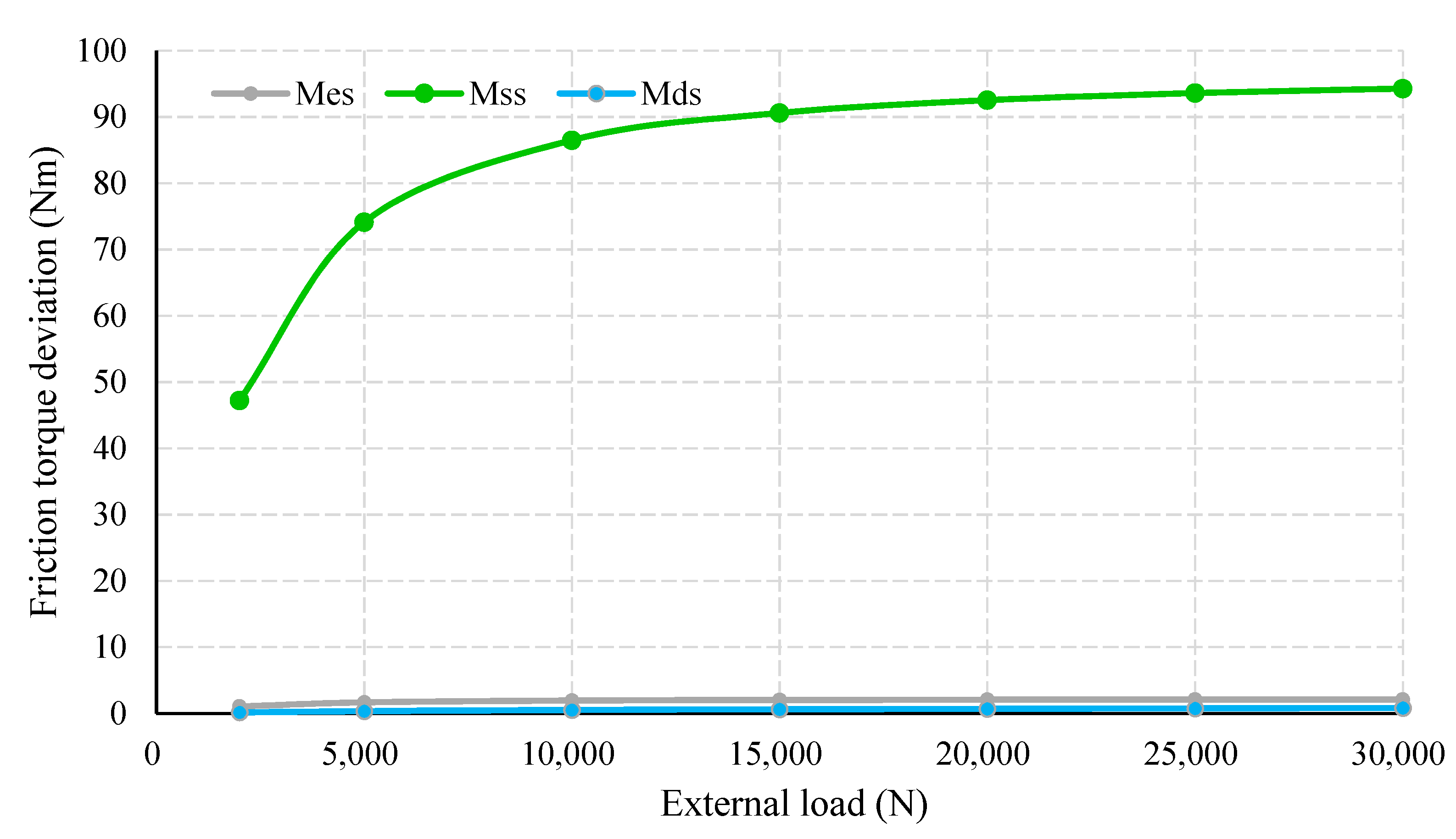
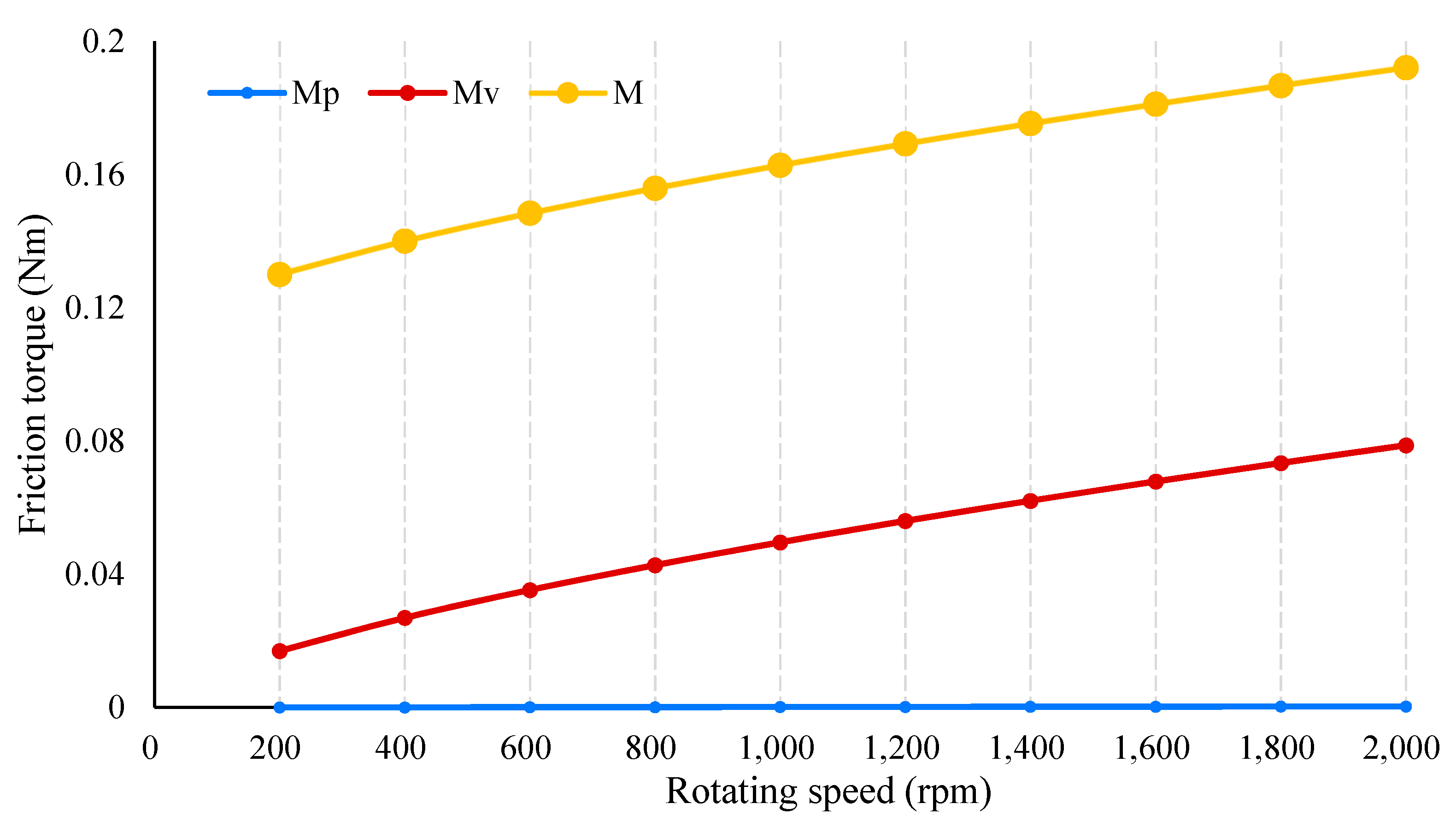
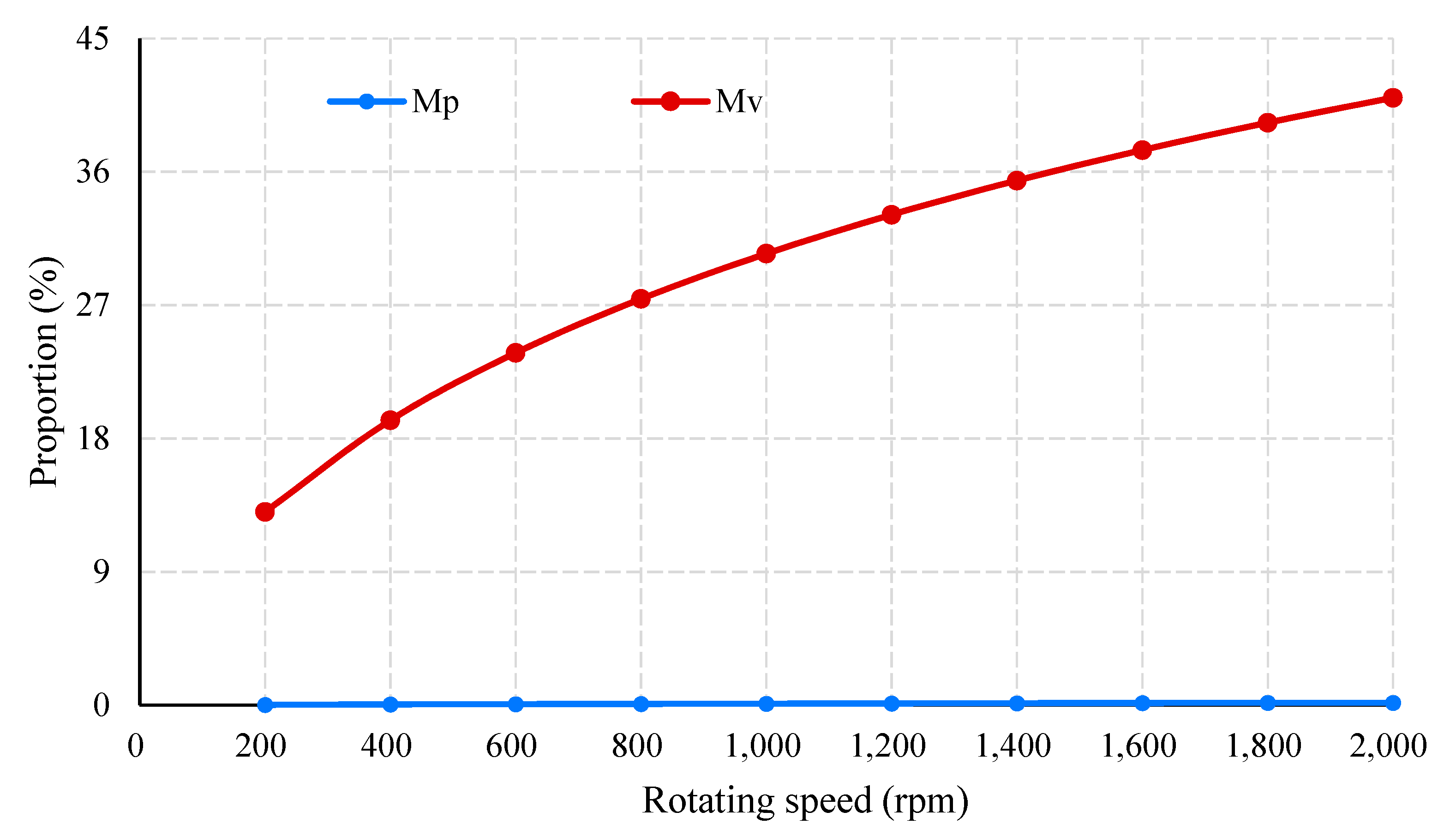


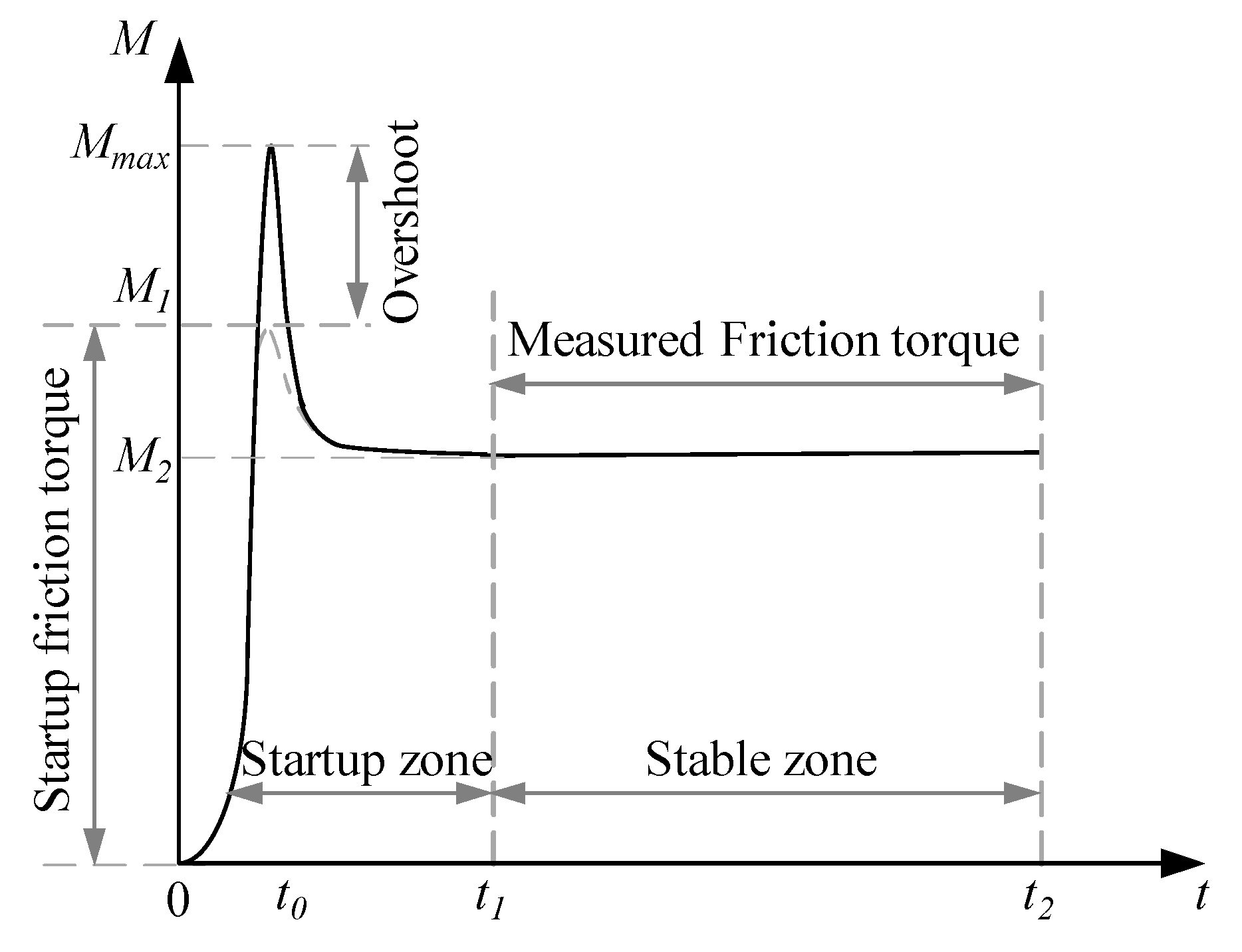
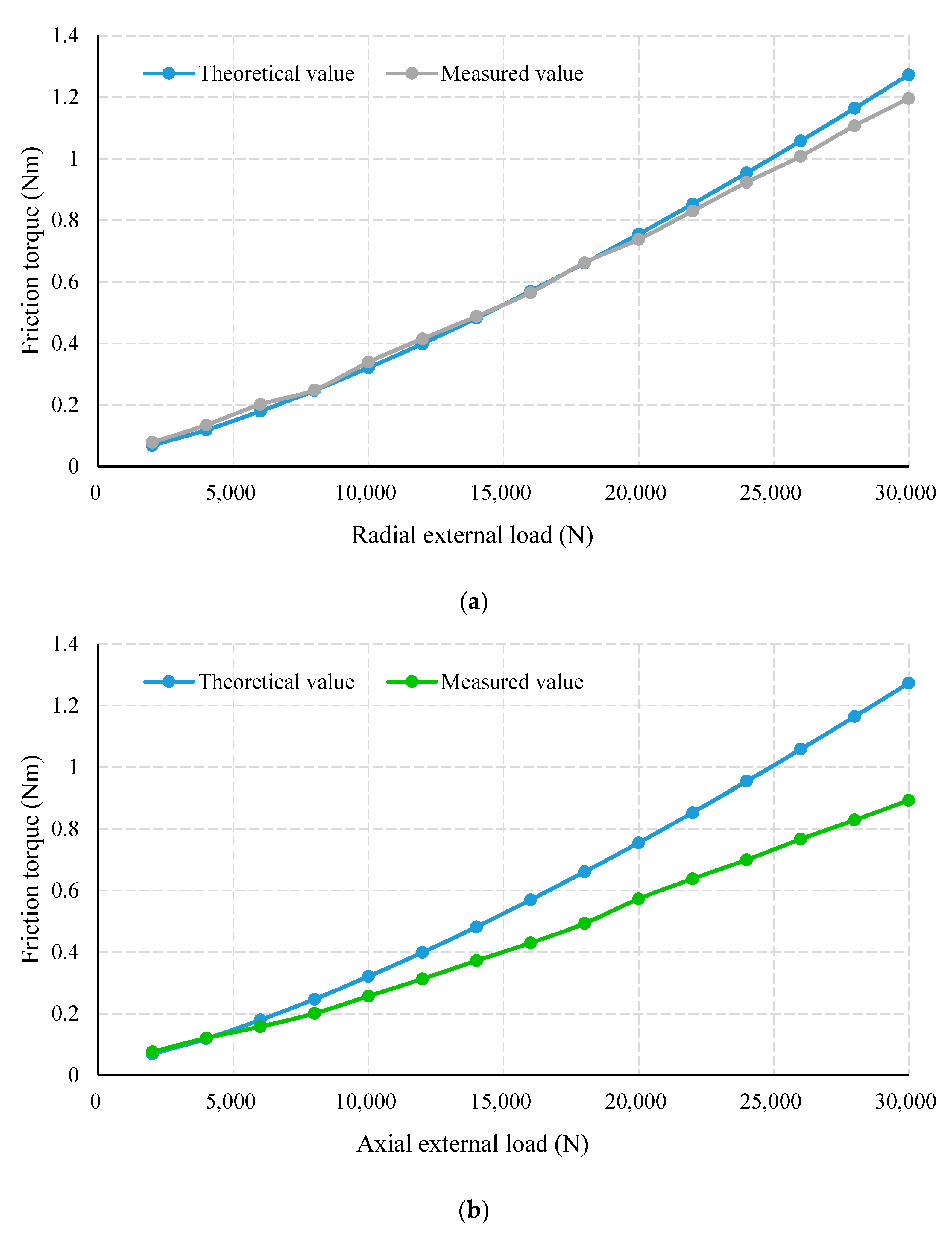
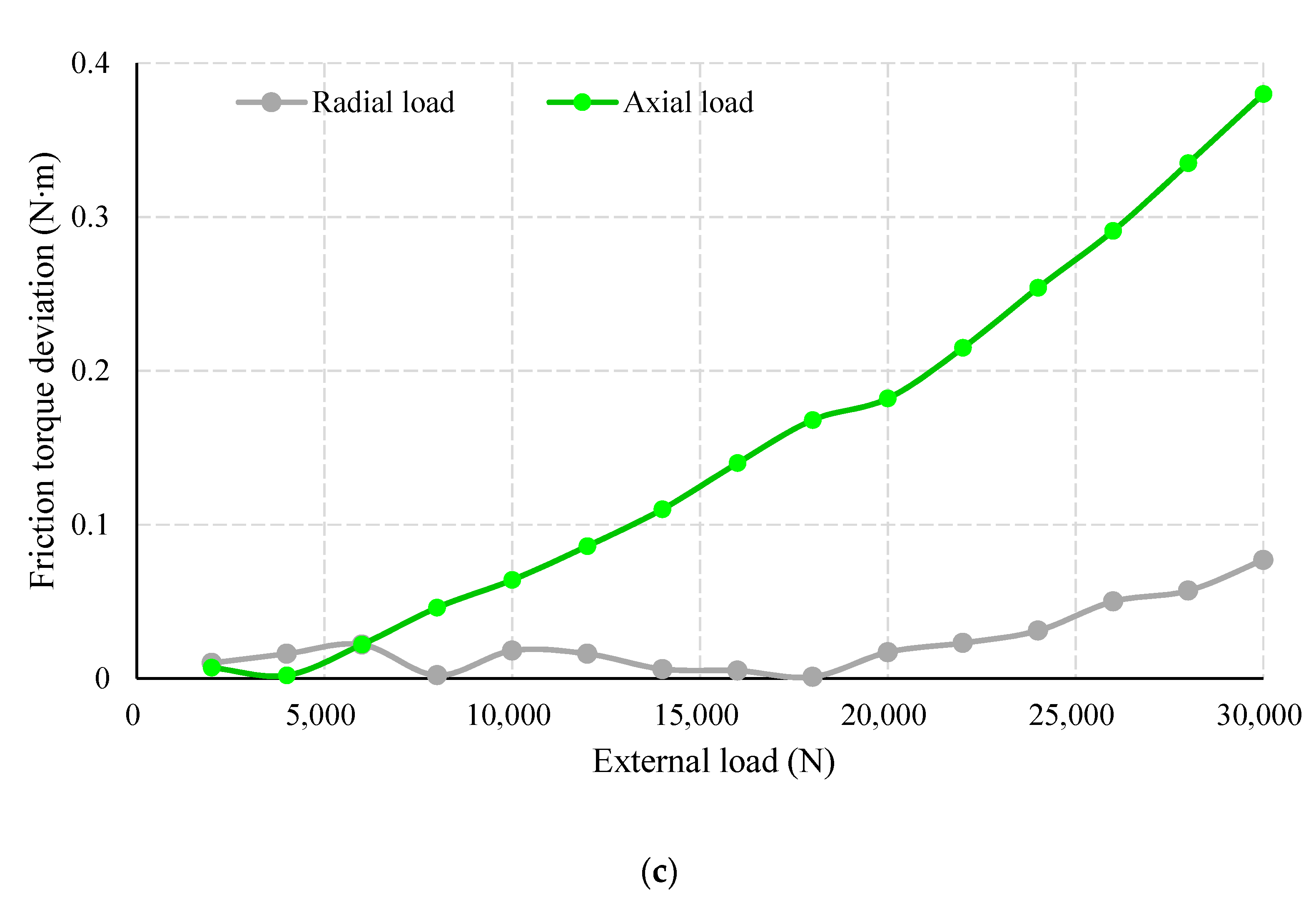

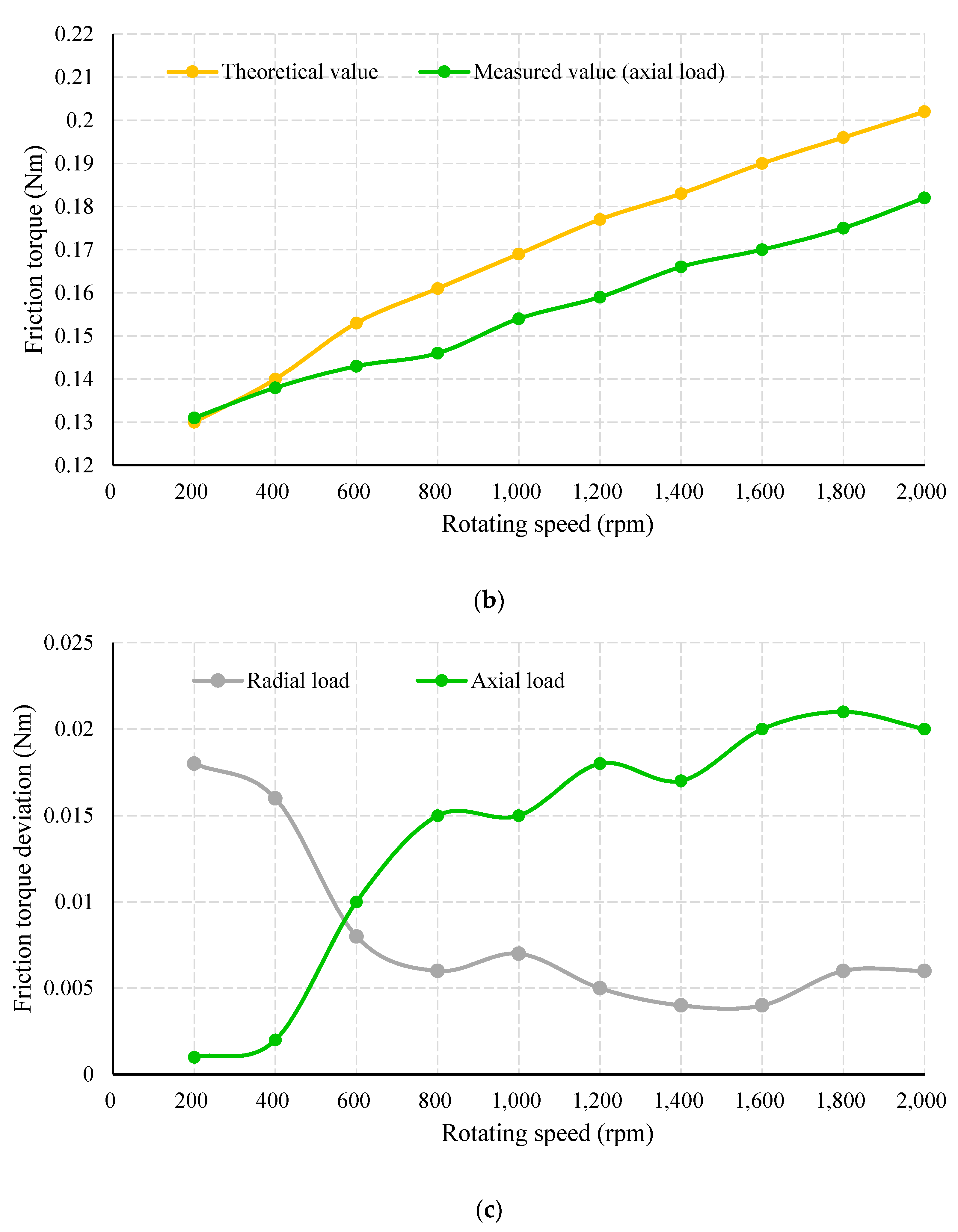
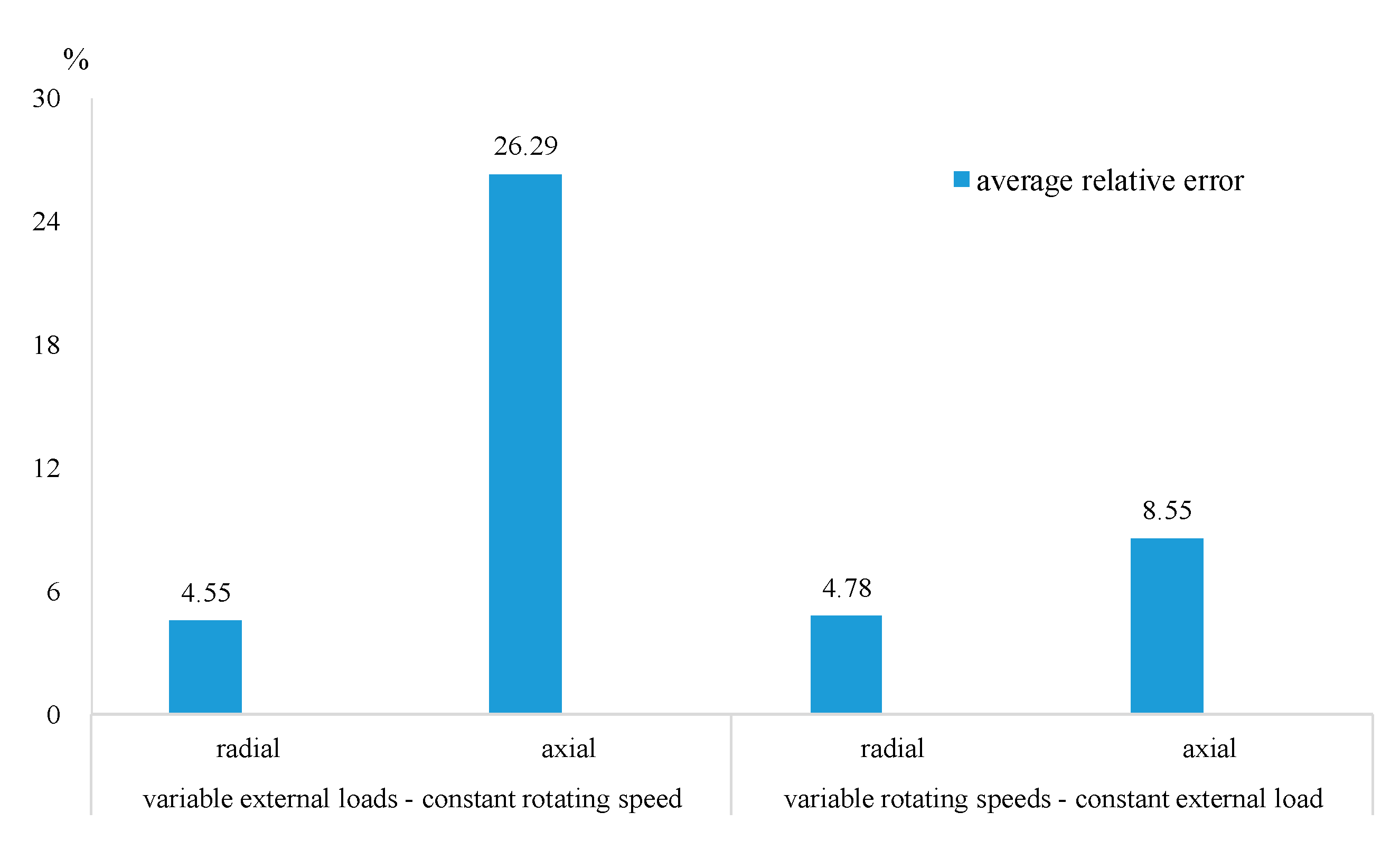
| Variety | Model | Size (mm × mm × mm) | Rated Radial Load (kN) | Rated Axial Load (kN) | ||||
|---|---|---|---|---|---|---|---|---|
| Inner Diameter | Outer Diameter | Thickness | Static | Dynamic | Static | Dynamic | ||
| Deep groove ball bearing | 6006 | 30 | 55 | 9 | 11.2 | 7.4 | - | - |
| 16006 | 30 | 55 | 13 | 13.2 | 8.3 | - | - | |
| Self-aligning ball bearing | 1206K | 30 | 62 | 16 | 15.8 | 4.7 | - | - |
| 2206KTN1 | 30 | 62 | 20 | 23.8 | 6.6 | - | - | |
| Single-row angular contact ball bearing | 7006C | 30 | 55 | 13 | 15.2 | 10.2 | - | - |
| Single-row angular contact ball bearing (pair mounting) | 7006 | 30 | 55 | 26 | 24.5 | 20.5 | - | - |
| Double-row angular contact ball bearing | 3206 | 30 | 62 | 23.8 | 25.2 | 20 | - | - |
| Thrust ball bearing | 51206 | 30 | 52 | 16 | - | - | 28.0 | 54.2 |
| Thrust angular contact ball bearing | 234406 | 30 | 55 | 32 | - | - | 10.78 | 28.2 |
| Spherical roller bearing | NUP | 30 | 55 | 13 | 13.0 | 12.8 | - | - |
| Double row cylindrical roller bearing | NN3306K | 30 | 55 | 19 | 29.2 | 35.5 | - | - |
| Self-aligning roller bearing | 22206 | 30 | 62 | 20 | 30.5 | 38.2 | - | - |
| Needle bearing | NA4906 | 30 | 47 | 17 | 25.2 | 35.5 | - | - |
| Tapered roller bearing | 32006 | 30 | 55 | 17 | - | - | 35.8 | 46.8 |
| Needle-angular contact ball combined bearing | NKIB5906 | 30 | 47 | 23 | 25.0 | 35.5 | 4.75 | 6.3 |
| PTRB | - | 30 | 55 | 18 | 30.2 | 19.3 | 33.2 | 38.3 |
| Parameter | Value | Parameter | Value |
|---|---|---|---|
| Index circle diameter of inner ring (mm) | 36.5 | Pocket diameter of planetary carrier (mm) | 3.5 |
| Index circle diameter of outer ring (mm) | 48.5 | Pocket depth of planetary carrier (mm) | 2 |
| Index circle diameter of threaded roller (mm) | 6 | Poisson ratio | 0.29 |
| PTRB inner diameter (mm) | 30 | PTRB pitch diameter (mm) | 42.5 |
| PTRB outer diameter (mm) | 55 | Rolling radius within inner ring (mm) | ∞ |
| Thread pitch of roller (mm) | 1.2 | Rolling radius within outer ring (mm) | ∞ |
| Contact angle (°) | 45 | Arc radius of threaded roller (mm) | 5.1 |
| Elastic modulus (E/MPa) | 210,000 | Thread number of threaded roller | 10 |
| Outer diameter of threaded roller (mm) | 6.4 | Number of rollers | 11 |
| Rotating Speed (rpm) | 600 | ||||||
|---|---|---|---|---|---|---|---|
| External Load (N) | 5000 | ||||||
| Roller Number | 7 | 8 | 9 | 10 | 11 | 12 | 13 |
| 0.0029 | 0.0028 | 0.0027 | 0.0026 | 0.0025 | 0.0024 | 0.0023 | |
| 0.128 | 0.123 | 0.118 | 0.114 | 0.110 | 0.107 | 0.102 | |
| 0.00072 | 0.00066 | 0.00061 | 0.00057 | 0.00053 | 0.00050 | 0.00048 | |
| 0.0001 | 0.0001 | 0.0001 | 0.0001 | 0.0001 | 0.0001 | 0.0001 | |
| 0.0353 | 0.0353 | 0.0353 | 0.0353 | 0.0353 | 0.0353 | 0.0353 | |
| 0.167 | 0.162 | 0.157 | 0.153 | 0.148 | 0.145 | 0.140 | |
| (a) Friction torque with 1000 rpm rotating speed. | |||||||
| Rotating Speed (rpm) | 1000 | ||||||
| External Load (N) | 5000 | 10,000 | 15,000 | 20,000 | 25,000 | 30,000 | |
| Value (Nm) | 0.002 | 0.006 | 0.011 | 0.016 | 0.021 | 0.027 | |
| Proportion (%) | 1.23 | 1.79 | 2.04 | 2.08 | 2.06 | 2.09 | |
| Value (Nm) | 0.110 | 0.277 | 0.476 | 0.699 | 0.941 | 1.199 | |
| Proportion (%) | 67.48 | 82.69 | 88.15 | 90.78 | 92.25 | 93.16 | |
| Value (Nm) | 0.001 | 0.002 | 0.003 | 0.005 | 0.008 | 0.011 | |
| Proportion (%) | 0.61 | 0.59 | 0.56 | 0.65 | 0.78 | 0.85 | |
| Value (Nm) | 0.163 | 0.335 | 0.540 | 0.770 | 1.020 | 1.287 | |
| (b) Friction torque with 2000 rpm rotating speed. | |||||||
| Rotating Speed (rpm) | 2000 | ||||||
| External Load (N) | 5000 | 10,000 | 15,000 | 20,000 | 25,000 | 30,000 | |
| Value (Nm) | 0.002 | 0.006 | 0.011 | 0.016 | 0.021 | 0.027 | |
| Proportion (%) | 1.04 | 1.65 | 1.93 | 2.00 | 2.00 | 2.05 | |
| Value (Nm) | 0.110 | 0.277 | 0.476 | 0.699 | 0.941 | 1.199 | |
| Proportion (%) | 57.29 | 76.10 | 83.66 | 87.48 | 89.70 | 91.04 | |
| Value (Nm) | 0.001 | 0.002 | 0.003 | 0.005 | 0.008 | 0.011 | |
| Proportion (%) | 0.52 | 0.55 | 0.53 | 0.63 | 0.76 | 0.84 | |
| Value (Nm) | 0.192 | 0.364 | 0.569 | 0.799 | 1.049 | 1.317 | |
| (c) Friction torque with 3000 rpm rotating speed. | |||||||
| Rotating Speed (rpm) | 3000 | ||||||
| External Load (N) | 5000 | 10,000 | 15,000 | 20,000 | 25,000 | 30,000 | |
| Value (Nm) | 0.002 | 0.006 | 0.010 | 0.016 | 0.021 | 0.027 | |
| Proportion (%) | 0.92 | 1.54 | 1.85 | 1.94 | 1.96 | 2.01 | |
| Value (Nm) | 0.110 | 0.277 | 0.476 | 0.699 | 0.941 | 1.199 | |
| Proportion (%) | 50.69 | 71.21 | 80.13 | 84.83 | 87.62 | 89.41 | |
| Value (Nm) | 0.001 | 0.002 | 0.003 | 0.005 | 0.008 | 0.011 | |
| Proportion (%) | 0.46 | 0.51 | 0.51 | 0.61 | 0.74 | 0.82 | |
| Value (Nm) | 0.217 | 0.389 | 0.594 | 0.824 | 1.074 | 1.341 | |
| (a) Friction torque with 10 kN external load | ||||||
| External Load (N) | 10,000 | |||||
| Rotating Speed (rpm) | 400 | 800 | 1200 | 1600 | 2000 | |
| Value (Nm) | 0.00006 | 0.00012 | 0.0019 | 0.00025 | 0.00032 | |
| Proportion (%) | 0.02 | 0.04 | 0.56 | 0.07 | 0.09 | |
| Value (Nm) | 0.027 | 0.043 | 0.056 | 0.068 | 0.079 | |
| Proportion (%) | 8.65 | 13.11 | 16.42 | 19.26 | 21.70 | |
| Value (Nm) | 0.312 | 0.328 | 0.341 | 0.353 | 0.364 | |
| (b) Friction torque with 20 kN external load | ||||||
| External Load (N) | 20,000 | |||||
| Rotating Speed (rpm) | 400 | 800 | 1200 | 1600 | 2000 | |
| Value (Nm) | 0.00006 | 0.00012 | 0.0019 | 0.00025 | 0.00032 | |
| Proportion (%) | 0.01 | 0.02 | 0.24 | 0.03 | 0.04 | |
| Value (Nm) | 0.027 | 0.043 | 0.056 | 0.068 | 0.079 | |
| Proportion (%) | 3.61 | 5.64 | 7.22 | 8.63 | 9.89 | |
| Value (Nm) | 0.747 | 0.763 | 0.776 | 0.788 | 0.799 | |
| (c) Friction torque with 30 kN external load | ||||||
| External load (N) | 30,000 | |||||
| Rotating speed (rpm) | 400 | 800 | 1200 | 1600 | 2000 | |
| Value (Nm) | 0.00006 | 0.00012 | 0.0019 | 0.00025 | 0.00032 | |
| Proportion (%) | 0.00 | 0.01 | 0.15 | 0.02 | 0.02 | |
| Value (Nm) | 0.027 | 0.043 | 0.056 | 0.068 | 0.079 | |
| Proportion (%) | 2.14 | 3.36 | 4.33 | 5.21 | 6.00 | |
| Value (Nm) | 1.264 | 1.280 | 1.294 | 1.306 | 1.317 | |
| Element | Type/Configuration | Quantity |
|---|---|---|
| Control module | EL4034, 4CH AO, Range: (−10~10)V, 12-bit, Conversion time: 250 μs | 1 |
| Data acquisition module | EL3104, 4CH AI, Range: (−10~10)V, 16-bit, Conversion time: 100 μs | 1 |
| Host computer | C6400-0050, CPU Intel Core i5, 8 GB RAM, 512 GB Disk | 1 |
| Servo motor | Z18, 15 kW, 15,000 rpm | 1 |
| Torque sensor | Measuring range: ±5 Nm, Accuracy: 2% | 1 |
| Tension-compression sensor | Measuring range: 3 T, Accuracy: 2% | 2 |
Publisher’s Note: MDPI stays neutral with regard to jurisdictional claims in published maps and institutional affiliations. |
© 2022 by the authors. Licensee MDPI, Basel, Switzerland. This article is an open access article distributed under the terms and conditions of the Creative Commons Attribution (CC BY) license (https://creativecommons.org/licenses/by/4.0/).
Share and Cite
Liu, L.; Zhang, C.; Guo, Y.; Bian, Y.; Fu, Y.; Ning, Y.; Zhou, J. Friction Torque Analysis and Verification of Planetary Thread Roller Bearing. Actuators 2022, 11, 238. https://doi.org/10.3390/act11080238
Liu L, Zhang C, Guo Y, Bian Y, Fu Y, Ning Y, Zhou J. Friction Torque Analysis and Verification of Planetary Thread Roller Bearing. Actuators. 2022; 11(8):238. https://doi.org/10.3390/act11080238
Chicago/Turabian StyleLiu, Lu, Congcong Zhang, Yanqing Guo, Yuxiang Bian, Yongling Fu, Yifan Ning, and Jinjie Zhou. 2022. "Friction Torque Analysis and Verification of Planetary Thread Roller Bearing" Actuators 11, no. 8: 238. https://doi.org/10.3390/act11080238





